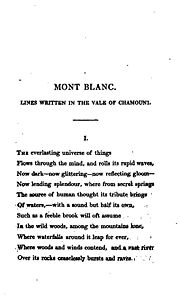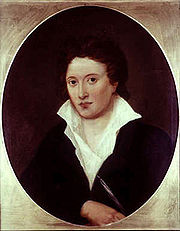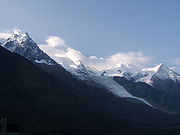
Mont Blanc (poem)
Encyclopedia


Ode
Ode is a type of lyrical verse. A classic ode is structured in three major parts: the strophe, the antistrophe, and the epode. Different forms such as the homostrophic ode and the irregular ode also exist...
by the Romantic poet
Romantic poetry
Romanticism, a philosophical, literary, artistic and cultural era which began in the mid/late-1700s as a reaction against the prevailing Enlightenment ideals of the day , also influenced poetry...
Percy Bysshe Shelley
Percy Bysshe Shelley
Percy Bysshe Shelley was one of the major English Romantic poets and is critically regarded as among the finest lyric poets in the English language. Shelley was famous for his association with John Keats and Lord Byron...
. The poem was composed between 22 July 1816 and 29 August 1816 during Percy Shelley's journey to the Chamonix
Chamonix
Chamonix-Mont-Blanc or, more commonly, Chamonix is a commune in the Haute-Savoie département in the Rhône-Alpes region in south-eastern France. It was the site of the 1924 Winter Olympics, the first Winter Olympics...
Valley, and intended to reflect the scenery through which he travelled. "Mont Blanc" was first published in 1817 in Percy Shelley and Mary Shelley
Mary Shelley
Mary Shelley was a British novelist, short story writer, dramatist, essayist, biographer, and travel writer, best known for her Gothic novel Frankenstein: or, The Modern Prometheus . She also edited and promoted the works of her husband, the Romantic poet and philosopher Percy Bysshe Shelley...
's History of a Six Weeks' Tour through a Part of France, Switzerland, Germany and Holland
History of a Six Weeks' Tour
History of a Six Weeks' Tour through a part of France, Switzerland, Germany, and Holland; with Letters Descriptive of a Sail Round the Lake of Geneva and of the Glaciers of Chamouni is a travel narrative by the British Romantic authors Mary Shelley and Percy Bysshe Shelley...
, which some scholars believe to use "Mont Blanc" as its culmination.
After Percy Shelley's early death in 1822, Mary Shelley published two collected editions of her husband's poetry; both of which included "Mont Blanc". Mary's promotion of his poetry helped to secure his enduring reputation and fame.
In "Mont Blanc", Percy Shelley compares the power of the mountain against the power of the human imagination. Although he emphasized the ability of the human imagination to uncover truth through a study of nature, he questions the notion of religious certainty. The poet concludes that only a privileged few can see nature as it really is, and are able to express its benevolence and malevolence through the device of poetry.
Composition and publication

Claire Clairmont
Clara Mary Jane Clairmont , or Claire Clairmont as she was commonly known, was a stepsister of writer Mary Shelley and the mother of Lord Byron's daughter Allegra.-Early life:...
(Mary Godwin's step-sister) he toured the Chamonix Valley
Chamonix
Chamonix-Mont-Blanc or, more commonly, Chamonix is a commune in the Haute-Savoie département in the Rhône-Alpes region in south-eastern France. It was the site of the 1924 Winter Olympics, the first Winter Olympics...
and visited Mont Blanc
Mont Blanc
Mont Blanc or Monte Bianco , meaning "White Mountain", is the highest mountain in the Alps, Western Europe and the European Union. It rises above sea level and is ranked 11th in the world in topographic prominence...
; Europe's highest mountain. Percy Shelley was inspired by the scenery surrounding a bridge over the Arve River in the Valley of Chamonix in Savoy
Savoy
Savoy is a region of France. It comprises roughly the territory of the Western Alps situated between Lake Geneva in the north and Monaco and the Mediterranean coast in the south....
, near Geneva
Geneva
Geneva In the national languages of Switzerland the city is known as Genf , Ginevra and Genevra is the second-most-populous city in Switzerland and is the most populous city of Romandie, the French-speaking part of Switzerland...
, and decided to set his poem in a similar landscape. He wrote that his verse was "composed under the immediate impression of the deep and powerful feelings excited by the objects which it attempts to describe; and, as an undisciplined overflowing of the soul, rests its claim to approbation on an attempt to imitate the untamable wilderness and inaccessible solemnity from which those feeling sprang". Later, when describing the mountains in general terms, he wrote, "The immensity of these aerial summits excited when they suddenly burst upon the sight, a sentiment of ecstatic wonder, not unallied to madness."
Shelley finished a draft of the poem before September, and it was published in 1817 as part of the Shelleys' travel narrative
Travel literature
Travel literature is travel writing of literary value. Travel literature typically records the experiences of an author touring a place for the pleasure of travel. An individual work is sometimes called a travelogue or itinerary. Travel literature may be cross-cultural or transnational in focus, or...
History of a Six Weeks' Tour. The published edition was not based on the first finished copy of Shelley's poem, but on a second copy written after Shelley misplaced the first. The first manuscript copy contains many differences from the first published edition and was discovered in December 1976. Advertisements for the Tour appeared on 30 October in the Morning Chronicle
Morning Chronicle
The Morning Chronicle was a newspaper founded in 1769 in London, England, and published under various owners until 1862. It was most notable for having been the first employer of Charles Dickens, and for publishing the articles by Henry Mayhew which were collected and published in book format in...
and on 1 November in The Times
The Times
The Times is a British daily national newspaper, first published in London in 1785 under the title The Daily Universal Register . The Times and its sister paper The Sunday Times are published by Times Newspapers Limited, a subsidiary since 1981 of News International...
, promising a 6 November release. However, it was not until 12 and 13 November that the work was actually published. It has been argued by leading Percy Shelley scholar Donald Reiman that History of a Six Weeks' Tour is arranged so as to lead up to "Mont Blanc". Tour editor Jeanne Moskal agrees with Reiman that the book was constructed to culminate in the poem and she notes that this was accomplished using a traditional hierarchy of genres—diary, letters, poem—a hierarchy that is gendered as Mary Shelley’s writings are superseded by Percy’s. However, these traditional gender-genre associations are undercut by the implicit acknowledgment of Mary Shelley as the primary author, with her journal giving the entire work its name and contributing the bulk of the text. Moreover, those who see the Tour as primarily a picturesque
Picturesque
Picturesque is an aesthetic ideal introduced into English cultural debate in 1782 by William Gilpin in Observations on the River Wye, and Several Parts of South Wales, etc. Relative Chiefly to Picturesque Beauty; made in the Summer of the Year 1770, a practical book which instructed England's...
travel narrative argue that the descriptions of Alpine scenes would have been familiar to early nineteenth-century audiences and they would not have expected a poetic climax.
The publication of "Mont Blanc" in History of a Six Weeks' Tour was the first and only publication of the poem during Percy Shelley's lifetime. In 1824, two years after his death, Mary Shelley included it in the first collection of his poems and later in her definitive Poetical Works of Percy Bysshe Shelley in 1840. Circumventing the ban that Percy Shelley's father had imposed upon her biographical writing, she added extensive editorial notes in these publications. She declared in 1824: "I am to justify his ways...I am to make him beloved to all posterity." As Mary Shelley scholar Betty T. Bennett
Betty T. Bennett
Betty T. Bennett was Distinguished Professor of Literature and Dean of the College of Arts and Sciences at American University. She was previously Dean of the School of Liberal Arts and Sciences and acting provost of Pratt Institute from 1979 to 1985...
explains, "biographers and critics agree that Mary Shelley's commitment to bring Shelley the notice she believed his works merited was the single, major force that established Shelley's reputation during a period when he almost certainly would have faded from public view".
Poem
"Mont Blanc" is a 144-line natural odeOde
Ode is a type of lyrical verse. A classic ode is structured in three major parts: the strophe, the antistrophe, and the epode. Different forms such as the homostrophic ode and the irregular ode also exist...
divided into five stanza
Stanza
In poetry, a stanza is a unit within a larger poem. In modern poetry, the term is often equivalent with strophe; in popular vocal music, a stanza is typically referred to as a "verse"...
s and written in irregular rhyme
Rhyme
A rhyme is a repetition of similar sounds in two or more words and is most often used in poetry and songs. The word "rhyme" may also refer to a short poem, such as a rhyming couplet or other brief rhyming poem such as nursery rhymes.-Etymology:...
. It serves as Shelley's response to William Wordsworth's
William Wordsworth
William Wordsworth was a major English Romantic poet who, with Samuel Taylor Coleridge, helped to launch the Romantic Age in English literature with the 1798 joint publication Lyrical Ballads....
Tintern Abbey
Tintern Abbey (poem)
"Lines composed a few miles above Tintern Abbey on revisiting the banks of the Wye during a tour, 13 July 1798" is a poem by William Wordsworth. Tintern Abbey is an abbey abandoned in 1536 and located in the southern Welsh county of Monmouthshire...
and as a "defiant reaction" against the "religious certainties" of Samuel Taylor Coleridge's
Samuel Taylor Coleridge
Samuel Taylor Coleridge was an English poet, Romantic, literary critic and philosopher who, with his friend William Wordsworth, was a founder of the Romantic Movement in England and a member of the Lake Poets. He is probably best known for his poems The Rime of the Ancient Mariner and Kubla...
"Hymn before Sun-rise, in the Vale of Chamouni", which "credits God for the sublime wonders of the landscape".
When the narrator of the poem looks upon Mont Blanc, he is unable to agree with Wordsworth that nature is benevolent and gentle. Instead, the narrator contends that nature is a powerful force:
- The everlasting universe of things
- Flows through the mind, and rolls its rapid waves,
- Now dark—now glittering—now reflecting gloom—
- Now lending splendour, where from secret springs
- The source of human thought its tribute brings
- Of waters... (Lines 1–5)
However, this force only seems to have power in relation to the human mind.
In the second stanza, the narrator turns to the Arve River as a representation of consciousness in nature. The Arve River and the ravine surrounding the river increase the beauty of the other:
- ...awful scene,
- Where Power in likeness of the Arve comes down
- From the ice gulphs that gird his secret throne,
- Bursting through these dark mountains like the flame
- Of lightning through the tempest... (Lines 15–19)
When the narrator witnesses the power of the Arve River, he claims:
- I seem as in a trance sublime and strange
- To muse on my own separate phantasy,
- My own, my human mind, which passively
- Now renders and receives fast influencing,
- Holding an unremitting interchange
- With the clear universe of things around; (Lines 35–40)
He realizes that knowledge is a combination of sensory perceptions and the ideas of the mind. The river can then serve as a symbol of a conscious power and a source for imaginative thought when he finishes the stanza, "thou art there!"
The third stanza introduces the connections between Mont Blanc and a higher power:
- Far, far above, piercing the infinite sky,
- Mont Blanc appears,—still, snowy, and serene—
- Its subject mountains their unearthly forms
- Pile around it, ice and rock; broad vales between
- Of frozen floods, unfathomable deeps,
- Blue as the overhanging heaven, that spread
- And wind among the accumulated steeps; (Lines 60–66)
Although the power may seem removed from mankind, it can still serve as a teacher. By listening to the mountain, one can learn that nature can be both benevolent and malevolent; good and evil emerge from conscious choice and one's relationship to nature:
- The wilderness has a mysterious tongue
- Which teaches awful doubt, or faith so mild,
- So solemn, so serene, that man may be
- But for such faith with nature reconciled;
- Thou hast a voice, great Mountain, to repeal
- Large codes of fraud and woe; not understood
- By all, but which the wise, and great, and good
- Interpret, or make felt, or deeply feel.(Lines 76–83)
The fourth stanza discusses the greater power behind the mountain:
- Power dwells apart in its tranquility
- Remote, serene, and inaccessible:
- And this, the naked countenance of earth,
- On which I gaze, even these primeval mountains
- Teach the adverting mind.... (Lines 96–100)
The power of the mountain, which encompasses both creation and destruction, parallels the power of the imagination.
Although nature can teach one about the imagination and offer truths about the universe, the poem denies the existence of natural religion
Natural religion
Natural religion might have the following meanings:* In the modern study of religion it is used to refer to the notion that there is a spontaneous religious apprehension of the world common to all human beings, see:**Urreligion**origin of religion...
. The power of the universe is symbolized by Mont Blanc, but for that power to have any meaning, one must exercise the imagination:
- Mont Blanc yet gleams on high:—the power is there,
- The still and solemn power of many sights,
- And many sounds, and much of life and death....
- ...The secret strength of things
- Which governs thought, and to the infinite dome
- Of heaven is as a law, inhabits thee!
- And what were thou, and earth, and stars, and sea,
- If to the human mind's imaginings
- Silence and solitude were vacancy?(Lines 127–129, 139–144)
Variations
In both language and philosophy, the first published edition of the poem varies from the copy found in the Scrope Davies Notebook and the original manuscript draft. For example, one important distinction between the published text and the manuscript versions is the line "But for such faith", which reads "In such a faith" in both the Scrope Davies notebook and the original manuscript. Critic Michael O'Neill argues that the Scrope Davies's version "makes the more evident sense, though it possibly sacrifices some of the tension" of the published version; he contends that the published version "is cryptic and tortuous, and yet the fact remains that Shelley chose to print the poem with this reading in his lifetime."Themes
"Mont Blanc" concerns the human mind and its ability to comprehend truth. Its main theme examines the relationship between the human mind and the universe; the poem discusses the influence of perception on the mind, and how the world can become a reflection of the operation of the mind. Although Shelley believed that the human mind should be free of restraints, he also recognised that nothing in the universe is truly free; he believed that there is a force in the universe to which the human mind is connected and by which it is influenced. Unlike Coleridge, Shelley believed that poets are the source of authority in the world, and unlike Wordsworth, believed that there was a darker side of nature that is an inherent part of a cyclical process of the universe; a notion similar to the theory put forth by the French naturalist George Cuvier.In "Mont Blanc", the poem's relationship with the mountain becomes a symbol for the poet's relationship with history. The poet is privileged because he can understand the truth found in nature, and the poet is then able to use this truth to guide humanity. The poet interprets the mountain's "voice" and relays nature's truth through his poetry. The poet, in putting faith in the truth that he has received, has earned a place among nature and been given the right to speak on this truth. Nature's role does not matter as much as the poet's mediation between nature and man. Shelley, and the poet in "Mont Blanc", opposes organised religion and instead offers an egalitarian replacement. However, only a select few can truly understand the secrets of the universe.
Reception
History of a Six Weeks' Tour received three reviews at the time of its publication, all generally favourable. Blackwood's Edinburgh Magazine quoted extensive excerpts from the third stanza, which contains similar themes and symbols as the "Letters from Geneva" in the Tour. The reviewer wrote that that poem was "too ambitious, and at times too close an imitation of Coleridge's sublime hymn on the vale of Chamouni". As critic Benjamin Colbert explains in his analysis of the reviews, "what points Shelley seems to score with this reviewer are not based on his originality or the provocative implications of his descriptions, but on his approximation of a success already mapped out by other travel writers".External links
- "Mont Blanc" at Representative Poetry Online
- "The Role of Consciousness: Mont Blanc and Tintern Abbey" by Valerie Steinberg at the Victorian Web
- Audiorecording of "Mont Blanc" read by Julian Jamison by LibriVox: http://librivox.org/long-poems-collection-004/

